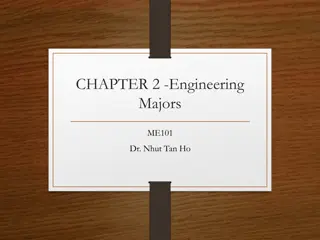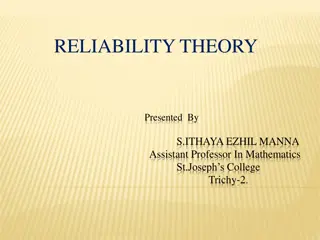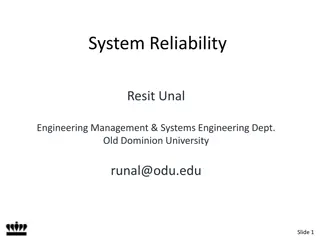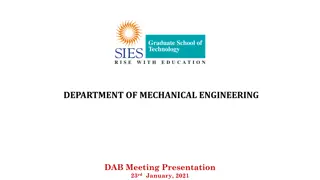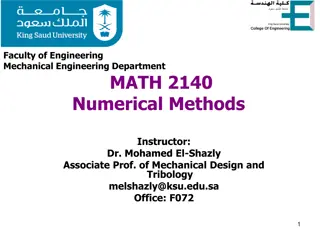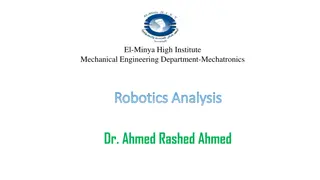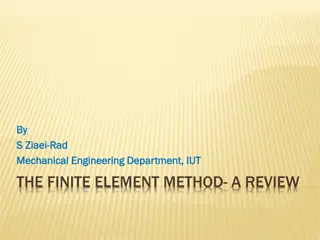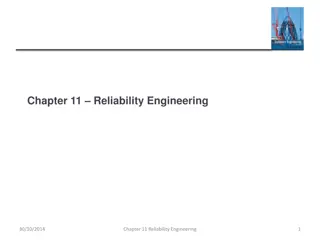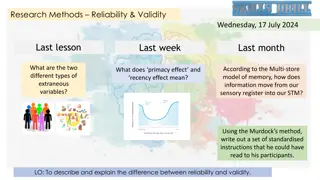Understanding Reliability in Mechanical Engineering
Reliability in mechanical engineering pertains to the ability of a product to perform as expected over a specified period under defined operational conditions. This article delves into the factors influencing reliability, such as numerical value, intended function, product life, and operating conditions. Key terms like failure rate, MTBF, and MTTF are also discussed to provide a comprehensive understanding of reliability concepts in machinery maintenance and installation.
Download Presentation

Please find below an Image/Link to download the presentation.
The content on the website is provided AS IS for your information and personal use only. It may not be sold, licensed, or shared on other websites without obtaining consent from the author. Download presentation by click this link. If you encounter any issues during the download, it is possible that the publisher has removed the file from their server.
E N D
Presentation Transcript
DEBRE MARKOS UNIVERSITY INSTITUTE OF TECHNOLOGY MECHANICAL ENGINEERING DEPARTMENT Instructor : Endalk B. MSc Maintenance And installation of machinery Maintenance And installation of machinery 1
Chapter 8 Reliability, Maintainability and Availability 8.1 Reliability Means quality over the long run, A product that works for a given long period of time is a reliable one, Since all units of a product will fail at different times, reliability is a probability. Note : lower equipment reliability means higher need for maintenance. 2
cont. Reliability is ability of a product to perform, as expected, over certain time. Formally defined as the probability that an item, a product, piece of equipment, or system will perform its intended function for a stated period of time under specified operating conditions. In the simplest sense, reliability means how long an item (such as a machine) will perform its intended function without a breakdown. Reliability is performance over time, probability that something will work when you want it to. 3
Cont. There are four factors associated with Reliability: 1. Numerical Value. The numerical value is the probability that the product will function satisfactorily during a particular time. 2. Intended Function. Product are designed for particular applications and are expected to be able to perform those applications. 4
Cont. 3. Life or time How long the product is expected to last. Product life is specified as a function of usage, time, or both. 4. Operating Conditions; These describe the operating conditions (environmental factors, humidity, vibration, shock, temperature cycle, operational profile, etc.) that correspond to the stated product life. . 5
Basic Reliability Terms Failure A failure is an event when an item is not available to perform its function at specified conditions , Frailer is when it is not capable of performing functions to specification. Failure Rate The number of failures per unit of gross operating period in terms of time, events, cycles. MTBF - Mean Time Between Failures The average time between failure occurrences. The number of items and their operating time divided by the total number of failures. For Repairable Items 6
Cont. MTTF - Mean Time To Failure The average time to failure occurrence. The number of items and their operating time divided by the total number of failures. For Repairable Items and Non-repairable Items Hazard The potential to cause harm. Harm including ill health and injury, damage to property, plant, products or the environment, production losses or increased liabilities. Risk The likelihood that a specified undesired event will occur due to the realization of hazard or during work activities by the products and services created by work activities. 7
Cont. Maintainability A characteristic of design, installation and operation, usually expressed as the probability that an item can be retained in, or restored to, specified operable condition. Maintainability it is specified interval of time when maintenance is performed in accordance with prescribed procedures. MTTR - Mean Time To Repair The average time to restore the item to specified conditions. 8
Cont. . Maintenance Load The repair time per operating time for an item. Availability A measure of the time that a system is actually operating versus the time that the system was planned to operate. It is the probability that the system is operational at any random time t. Supportability The ability of a service supplier to maintain the Plant inbuilt reliability and , To perform scheduled and unscheduled maintenance according to the Plant inbuilt maintainability with minimum costs. 9
cont. Reliability Engineering is concerned with analyzing failures and providing feedback to design and production to prevent future failures. Reliability engineers usually speaks of Failures Causes Failure Modes Failure Mechanisms A failure is an event at which the system stops to fulfill its specified function. 10
Cont. Reliability measurement is based on the failure rate Items Failed = Failure rate Total Operating Time Some products (Non-repairable) are scrapped when they fail e.g. bulb Other products (Repairable) are repaired e.g. washing machine. 11
How Do Products Really Fail ? Two common types of failures: 1. Sudden failure (no indicators): Stress exceeds strength . 2. Degradation (gradual wear out): degradation indicator such as crack growth, change of resistance, corrosion, This is ideal for Condition-Based Maintenance Other failures may occur because of human errors. Failure rate over the life of a product Failure rate over the life of a product The failure rate is expected to vary over the life of a product Bathtub Curve 12
Bathtub Curve. Bathtub Curve Bathtub Curve A curve used in reliability engineering , describing a particular form of hazard function taking in to account three categories of failure. A-B Early Failure / Infant mortality / Debugging / Break-in Teething problems. Caused by design/material flaws Eg: Joints, Welds, Contamination, Misuse, Miss - assembly B-C Constant Failure / Useful life. Lower than initial failure rate and more or less constant until end of life C-D End of life failure / Wear out phase. Failure rate rises again due to components reaching end of life E.g.:- Corrosion, Cracking, Wear, Friction, Fatigue, Erosion, Lack of PM 13
Bathtub Curve: Summary Table Bathtub Curve: Summary Table 14
Managing Reliability Reliability management is concerned with performance and conformance over the expected lifeof the product A systems approach to planning for, designing in, verifying, and tracking the reliability of products throughout their life to achieve reliability goals. Reliability of a system is often specified by the failure rate . = failures per time unit (in a collection of systems) For most technical products (incl. embedded systems), (t) is a bath-tub curve : 15
System Reliability As products become more complex (have more components), the chance that they will not function increases. The method of arranging the components affects the reliability of the entire system. Components can be arranged in a) Series b) parallel, or a combination 16
(a) (a)Series System For a series systems, the reliability is the product of the individual components. For a series systems, the reliability is the product of the individual components. As components are added to the series, the system reliability decreases. Example : four wheels of a car 17
Cont.. Example Consider series system structure of three independent component with same reliability of 0.9 for a specified time period t. Wheat will be the reliability of this structure for s specified time period t ? 18
Cont.. 19
Cont.. Example on system failure and MTTFS Assume that the constant failure rates of tires 1 , 2, 3, and 4 of a car are 1 = 0.00001 failures per hour, 2 = 0.00002 failures per hour, 3 = 0.00003 failures per hour, and 4 = 0.00004 failures per hour, respectively. For practical purposes, the car cannot be driven when any one of the tires punctures or split . Calculate the total tire system failure rate and mean time to failure of the car with respect to tires. Solution S = 0.00001 + 0.00002 + 0.00003 + 0.00004 = 0.0001 failures per hour MTTFS = 1 / S = 1 /0.0001 = 10,000 h 20
b)Parallel System When a component does not function, the product continues to function, using another component, until all parallel components do not function. 21
Cont. Example consider a parallel structure of three independent component. their reliability are estimated to be 0.9 , 0.8, and 0.5 for specified time period t. What will be the reliability of this structure for a specified period t. 22
Cont. Example on parallel system An aircraft has two independent and active engines. At least one engine must operate normally for the aircraft to fly. Engines 1 and 2 reliabilities are 0.99 and 0.97, respectively. Calculate the probability of the aircraft flying successfully with respect to engines. Solution There is 99.97% chance that the aircraft will fly successfully with respect to engines. 23
(c) Series-Parallel System or Mixed Configuration Convert to equivalent series system 24
Cont.. Example on mixed configuration Consider a mixed structure system reliability component A has reliability of 0.9, component B and C have the reliability of 0.8. calculate the reliability of this system for a specified period t ? 25
Exponential Failure Analysis Exponential distribution: 26
Cont. Example Following time to frailer of an item are exponentially distributed ; 75, 100 ,70 , 130 and 125 in hours . Calculate the reliability of the item for an operating period of 100 hours? 27
Weibull Failure Analysis When = 1 , the hazard function is constant and therefore the data can be modeled by an exponential distribution with =1 / . When <1 , we get a decreasing hazard function and When >1 , we get a increasing hazard function When >3.5, the Weibull distribution is an approximation for the Normal distribution. Where is the Weibull slope. 28
Cont 29
Cont. Reliability analysis using wiebull distribution Time to failure of a pipeline valve is assumed to have , wiebull distribution with a shape parameter 2 and scale parameter 4000 hours. Calculate the reliability of the valve for an operation period of 2000, 4000, and 6000 hours. 30
Reliability Characteristics Non-Repairable Systems: Reliability=Availability Failure Rate MTTF Time to First Failure MRL (Mean Residual or remaining Life) Repairable Systems: Availability . (Function of Reliability and Maintainability) Failure Rate and Repair Rate MTBF 31
Failure Rate for Repairable and Non-repairable systems MTBF ( ) = Total time Total Number of failures Average Failure Rate = 1 = 1 Fialer rate =no of failure divided by total no of hours Example 1 1) 300 cars have accumulated 45000 hours, 10 failures are observed. What is the MTBF? and What is the failure rate? Note: Note: considering Car as repairable system, Use MTBF MTBF = 45000/10 = 4500 hours. Failure rate = 10/45000 = 0.00022 per hour. 32
Cont.. Example 2 : Five oil pumps were tested with failure hours of 45, 33, 62, 94 and 105. What is the MTTF and failure rate? Note:- considering pumps as non repairable systems, Use MTTF. MTTF = (45+33+62+94+105) / 5 = 67.8 hours Failure rate = 5 / (45+33+62+94+105) = 0.0147 per hour. Note that MTTF is a reciprocal of failure rate. 33
Example 3 10 components were tested. The components (not repairable) failed as follows:- Component 1,2,3,4,5 failed after 75,125, 130, 325, 525 hours. Find the failure rate and mean time till failure. Solution:- No. of failures = 5 Total operating time = 75 + 125 + 130 + 325 + 525 + 5*525 = 3805 Failure rate = 5 / 3805 = 0.001314 Mean time till failure = 1/ =1/0.001314 = 761.04 hours. 34
Example 4 50 components are tested for two weeks. 20 of them fail in this time, with an average failure time of 1.2 weeks. What is the mean time till failure assuming a constant failure rate? Answer: No. Of failures = 20 Total time = 20*1.2 + 30*2 = 84 weeks Failure rate = 20/84 = 0.238/week Mean time till failure is estimated to be = (1/failure rate) = 1/0.238 = 4.2 weeks. 35
Example 5 The chart below shows operating time and breakdown time of a machine. 36
Cont. = 4 / 136.9 = 0.02922 Therefore; = MTBF = 1/ = 34.22 hours b) What is the system reliability for a mission time of 20 hours? R = e R = e- - t t t = 20 hours R= e-(0.02922)(20) R = 55.74% 37
Maintainability Maintainability is the measure of the ability of a system or item to be retained or restored to a specified condition when maintenance is performed by qualified personnel using specified procedure and resources. Maintabnility can be measured with Mean Time To Repair (MTTR), MTTR is average repair time and is given by MTBMA is Mean Time Between Maintenance Actions including preventive and corrective maintenance tasks. int Total Ma Total Number of Ma enance DownTime enance Actions = MTTR int . 38
OBJECTIVES OF MAINTAINABILITY To influence design and to achieve event of maintenance thus reducing maintenance time & cost, To estimate the downtime for maintenance which, when compared with allowable downtime, determines whether redundancy is required, To estimate system availability by combining maintainability data with reliability data, To estimate the man-hours and other resources required for performing maintenance, 39
ADVANTAGES OF MAINTAINABILITY PREDICTION 1. It highlights areas of poor maintainability which require product improvement, modification or change of design. 2. It permits user to make an early assessment of whether the predicted downtime, the quality, quantity of personnel, tools and test equipment are adequate and consistent with the needs of system operational requirements. 40
Types of system maintenance actions: A) A) corrective maintenance corrective maintenance Actions taken to restore a failed system to operational status, Usually involves replacing or repairing the component that is responsible for the failure of the overall system, Corrective maintenance is performed at unpredictable intervals because a component's failure time is not known a priori and, The objective of corrective maintenance is to restore the system to satisfactory operation within the shortest possible time. 41
Cont. Diagnosis of the problem Maintenance technician takes time to locate the failed parts or otherwise satisfactorily assess the cause of the system failure Repair and/or replacement of faulty component Action is taken to address the cause, usually by replacing or repairing the components that caused the system to fail Verification of the repair action Once components have been repaired or replaced, the maintenance technician must verify that the system is again successfully operating 42
B) preventive maintenance B) preventive maintenance The practice of replacing components or subsystems before they fail to promote continuous system operation The preventive maintenance schedule is based on: Observation of past system behavior Component wear-out mechanisms Knowledge of components vital to continued system operation Cost is always a factor in the scheduling of preventive maintenance Reliability may be a factor, but cost is a more general term because reliability & risk can be expressed in terms of cost In many circumstances, it may be financially better to replace parts or components that have not failed at predetermined intervals rather than wait for a system failure that may result in a costly disruption in operations 43
C) Inspections C) Inspections Used to uncover hidden failures (also called dormant failures) In general, no maintenance action is performed on the component during an inspection unless the component is found failed causing a corrective maintenance action to be initiated Sometimes there may be a partial restoration of the inspected item performed during an inspection For example, when checking the motor oil in a car between scheduled oil changes, one might occasionally add some oil in order to keep it at a constant level 44
Maintenance Downtime Maintenance Downtime There is time associated with each maintenance action, i.e. amount of time it takes to complete the action. This time is referred to as downtime & defined as the length of time an item is not operational There are a number of different factors that can affect the length of downtime Physical characteristics of the system, Repair crew availability, Spare part availability & other ILS factors , and Human factors & Environmental factors There are two Downtime categories for these factors: Waiting Downtime & Active Downtime. 45
Types of Maintenance Downtime Types of Maintenance Downtime Waiting Downtime The time during which the equipment is inoperable or unworkable , but not yet undergoing repair For example, the time it takes for replacement parts to be shipped, administrative processing time, etc. Active Downtime The time during which the equipment is inoperable and actually undergoing repair The active downtime is the time it takes repair personnel to perform a repair or replacement The length of the active downtime is greatly dependent on human factors and the design of the equipment For example, the ease of accessibility of components in a system has a direct effect on the active downtime. 46
Cont. Maintainability is a function of the design of the system, the personnel available at the necessary skill levels, the procedures available to perform the maintenance, the test equipment available, and the environment in which the maintenance must be performed. Maintainability is measured by Mean-Time-To-Repair (MTTTR). int Total Ma Total Number of Ma enance DownTime enance Actions = MTTR int . where n = number of subsystems ?? = failure rate of ?? system ??? = Repair time for the ?? unit 47
Probability of Repair Within the Allowable Downtime Probability of Repair Within the Allowable Downtime To calculate the probability of performing a maintenance action within an allowable time interval use: Mean Mean- -Time Time- -To To- -Repair Repair M(t) = 1 e - t / MTTR The total corrective maintenance time divided by the total number of corrective maintenance actions during a given period of time. Where: t = Allowable downtime MTTR= Expected downtime (MTTR) Example: What is the probability of completing an action within 5 hours if the MTTR = 7 hours? Solution: M(t) = 1 e - t/MTTR = 1 e5/7 = 1 - .4895 = .5105 There is approximately a 51% probability of completion. 48
Availability Availability defined as the probability that an item will be available when required or as the proportion of total time that an item is available for use. May be defined as the probability an item is operable & can be committed at the start of a mission when the mission is called for at any unknown (random) point in time. Example: For a lamp with a 99.9% availability, there will be one time out of a thousand that someone needs to use the lamp and finds it is not operating. 49
Cont.. Availability issues deal with at least three main factors for - Increasing time to failure -Decreasing downtime due to repairs or scheduled maintenance and - Accomplishing items 1 and 2 in a cost be effective manner. As availability grows , the capacity for making money increases because the equipment is in service a larger percent of time. 50


